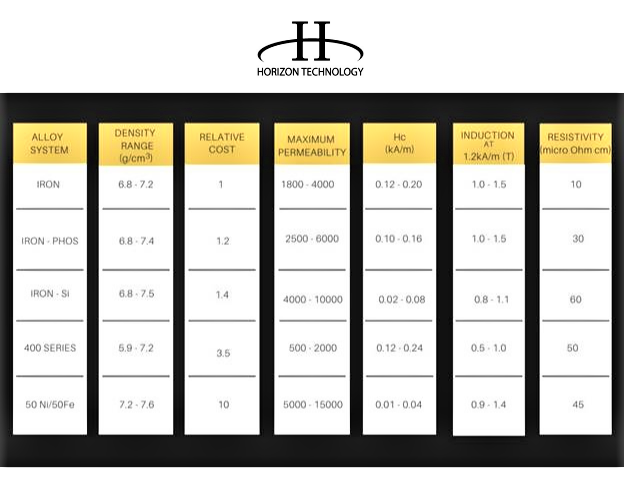There’s no shortage of engineers coming to Horizon and other metal manufacturers with design issues relating to magnetism. Perhaps most interestingly, there’s a push to increase the magnetic saturation in DC motors.
Luckily, the rules of powder metallurgy allow for a solution. Powder metallurgy (PM) offers a wide variety of materials to satisfy many DC magnetic applications. The industry has several alloying elements at its disposal, all with varying goals:
- Increasing permeability
- Decrease coercivity
- Increasing mechanical properties
But we’re here to talk about magnetics, right? The table below gives the most common ferrous sintered powder metal magnetic materials, plus a brief overview of their relative magnetic performance.
The Relevance of Magnetic Saturation in DC Motors
If you’re saying, “Wait. … What’s magnetic saturation?” we can back up a bit. It’s best to start by defining magnetic permeability.
Magnetic Permeability
Magnetic permeability is the level of magnetization a material receives from an applied magnetic field. The permeability changes with the amount of magnetic flux forced through your material.
Response time is often related to the magnetic permeability -- the higher the permeability, the quicker the response time. In the table below, moving your powder choice from pure iron to iron-phosphorus to iron-silicon increases the permeability. There’s also a corresponding decrease in coercivity -- both good features for quick response and improved performance!
Magnetic Saturation
Magnetic saturation’s meaning is simply that increasing an external magnetic field can no longer increase the magnetization of your material.
If you want a deeper dive on magnetic properties and density, try this article.
What powder metal gives is the ability to tailor your component’s density to fit specific needs. For example, the magnetic flux generated in a design using PM at 6.8 g/cm³ may require an additional iron component to prevent stray flux from leaking into the surrounding components. If you need to keep certain parts nonmagnetic, that’s a no-no. Increasing the part’s density can increase the saturation flux density, eliminating the need for an additional component.
Voila! You’ve achieved a net cost reduction.
About the Chart
Prealloyed nickel iron offers the best permeability and lowest coercive force. Although not a large segment in powder metallurgy magnetics, this material is the absolute best. Anyone remember dot matrix printers? The flux piece was made with nickel-iron to give the highest response and print speed.
 Do you want a magnetic part with corrosion resistance? The 400 series of stainless steels is your answer. These were very common in the original antilock brake system where the tone wheel was exposed to the elements. They offered good magnetic response with the necessary corrosion resistance.
Do you want a magnetic part with corrosion resistance? The 400 series of stainless steels is your answer. These were very common in the original antilock brake system where the tone wheel was exposed to the elements. They offered good magnetic response with the necessary corrosion resistance.
Now you can merge these magnetic properties with the unique design capabilities of powder metallurgy to produce shapes that best fit your needs. A skilled powder metallurgy supplier can tailor the processing (sintering temperature and sintering atmosphere) to take the performance levels of these materials even further.
Cost
You can do all of this with powder metal, but there is an associated cost penalty when you move up in materials. A higher-performing material will naturally cost more.
It’s up to the engineer and purchasing folks to decide how much performance matters to your competitive advantage.
What About AC Applications?
These materials and options work best for DC applications. But what if your needs are for an AC device?
In those cases, you’ll still want to take advantage of powder metallurgy, but with a different material: soft magnetic composite. This supermaterial requires a different set of design considerations for powder metallurgy use. We have an entire set of resources dedicated to that material, which you can find here.
Whether your application is DC or AC, we’re guessing you have more questions on magnetic materials used in electrical machines. That’s OK -- just ask one of our engineers directly via the button below:



